Majiang History
关于麻将起源的知识点总结
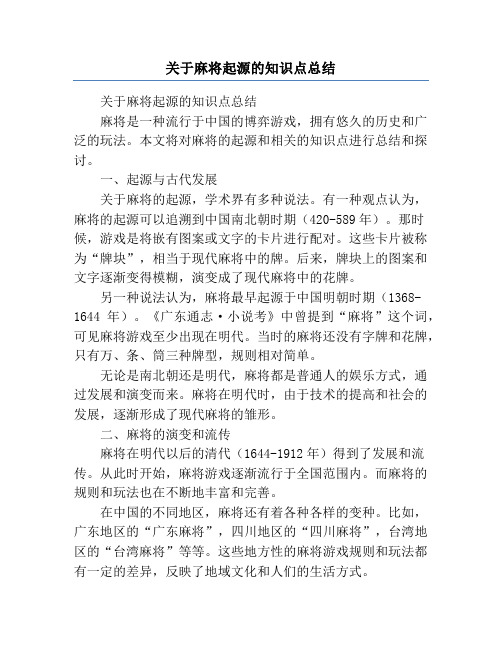
关于麻将起源的知识点总结关于麻将起源的知识点总结麻将是一种流行于中国的博弈游戏,拥有悠久的历史和广泛的玩法。
本文将对麻将的起源和相关的知识点进行总结和探讨。
一、起源与古代发展关于麻将的起源,学术界有多种说法。
有一种观点认为,麻将的起源可以追溯到中国南北朝时期(420-589年)。
那时候,游戏是将嵌有图案或文字的卡片进行配对。
这些卡片被称为“牌块”,相当于现代麻将中的牌。
后来,牌块上的图案和文字逐渐变得模糊,演变成了现代麻将中的花牌。
另一种说法认为,麻将最早起源于中国明朝时期(1368-1644年)。
《广东通志·小说考》中曾提到“麻将”这个词,可见麻将游戏至少出现在明代。
当时的麻将还没有字牌和花牌,只有万、条、筒三种牌型,规则相对简单。
无论是南北朝还是明代,麻将都是普通人的娱乐方式,通过发展和演变而来。
麻将在明代时,由于技术的提高和社会的发展,逐渐形成了现代麻将的雏形。
二、麻将的演变和流传麻将在明代以后的清代(1644-1912年)得到了发展和流传。
从此时开始,麻将游戏逐渐流行于全国范围内。
而麻将的规则和玩法也在不断地丰富和完善。
在中国的不同地区,麻将还有着各种各样的变种。
比如,广东地区的“广东麻将”,四川地区的“四川麻将”,台湾地区的“台湾麻将”等等。
这些地方性的麻将游戏规则和玩法都有一定的差异,反映了地域文化和人们的生活方式。
随着时间的推移,麻将逐渐传播到日本、韩国以及其他亚洲国家。
日本在大正时代(1912-1926年)引进了麻将,并对其进行了改良和发展,形成了现代日本麻将的特色。
三、麻将的发展和变革随着社会的发展和人们对娱乐方式的需求的提升,麻将也在不断地发展和变革。
首先,麻将的规则和玩法在不断地丰富和完善。
随着时代的变迁,人们的生活方式和文化背景也在不断变化,因此麻将游戏也不断地进行调整和改进。
比如,有些麻将变种中引入了彩头、多番等元素,使得游戏更加有趣和刺激。
其次,麻将逐渐从传统的实体游戏转变为线上游戏。
麻将规则图解

麻将的高手心得与经验分享
麻将的高手心得
麻将的经验分享
• 心态:保持平和,谨慎行牌
• 实战:多参与实战,提高经验与技巧
• 观察:细致观察对手的行牌与表情
• 学习:学习高手的心得与技巧
• 策略:灵活运用各种战术与策略
• 交流:与朋友交流麻将经验,共同提高
06
麻将的娱乐与竞技
• 纽约麻将的东海岸玩法
• 洛杉矶麻将的西海岸玩法
• 芝加哥麻将的中西部玩法
麻将的演变与普及
麻将的演变过程
⌛️
• 从麻雀牌到麻将
• 麻将牌的不断增加与完
善
• 各地区的麻将规则差异
麻将的现代发展
• 线上麻将的兴起
麻将的普及原因
• 麻将比赛的举办
• 麻将文化的传承与传播
• 简单易学的游戏规则
• 丰富的策略与技巧
• 强烈的社交属性
02
麻将的基本规则
麻将的牌具与分类
麻将的牌具
麻将的分类
• 麻将牌共有144张
• 国标麻将:144张牌
• 万子、条子、筒子、字牌四类
• 四川麻将:108张牌,无花牌
• 春夏秋冬、梅竹兰菊八种花牌
• 广东麻将:136张牌,有花牌
• 台湾麻将:16张牌,无花牌
麻将的玩法与流程
麻将的玩法
麻将的竞技赛事
麻将的比赛规则
• 麻将比赛:各地举办的麻将比赛
• 国标麻将:遵循国标麻将的规则与计分
• 线上比赛:网络平台上的麻将比赛
• 地区规则:各地地区的特色规则
• 锦标赛:国际麻将锦标赛等高级赛事
• 比赛规则:比赛组织者制定的特殊规则
中国麻将Presentation(MaJiong)

Mahjong tiles瓷砖,瓦,一块麻将
at least 136 tiles (most commonly 144)
America or Japan will have more. Divide them into these three parts: suits, honors, and flowers.
Negative effects
money-based game.
addiction
long-time sit is harmness to our health
Positive effects
Enriching the life of old people. Promoting the communication between countries.
Flowers(Bonus tiles) Only eight bonus tiles: four flowers and four seasons
The history
Who created the game
?
1、In memory of the heros of Liangshan. Wanbingtiao(万秉迢)
Suits three different suits numbered 1 to 9 bamboo (bams) characters (or myriads ) circles (or dots).
Honors:
Two different honor suits: the winds and the dragons. The winds : east, south, west and north The dragons : Red, Green and White.
麻将的英语演讲带翻译
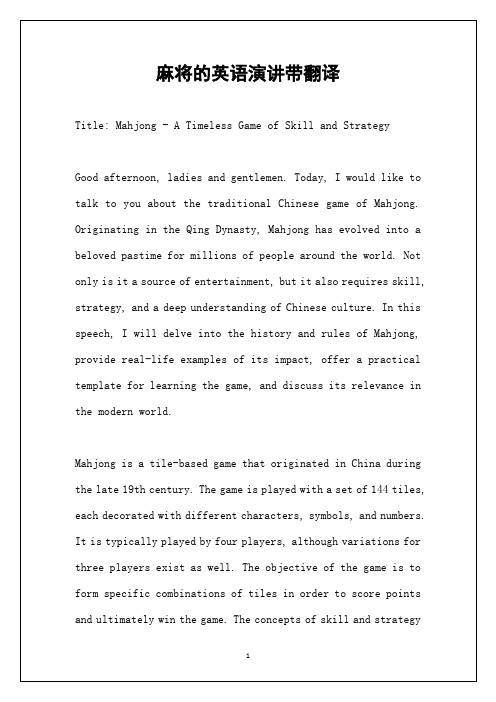
麻将是一种基于牌砖的游戏,起源于19世纪末的中国。该游戏使用144张不同图案、符号和数字装饰的牌砖。游戏通常由四个玩家参与,但也存在适用于三个玩家的变体。游戏的目标是通过组成特定的牌组来得分并最终赢得比赛。在麻将中,技巧和策略的概念至关重要,玩家必须根据自己接收到的牌砖和对手的行动不断调整自己的策略。
Thank you for your attention.
翻译:
麻将 - 一款充满技巧和策略的不朽游戏
麻将的起源和名称的由来

麻将的起源和名称的由来麻将,是一种在许多亚洲国家和地区广泛流传的游戏,是众多玩家喜欢的活动之一。
麻将游戏具有多种规则和变化形式,但不管怎样,它的基础是一组144张牌,玩家在游戏中运用智慧进行组合和比拼。
那么,麻将的起源和名称的由来是什么呢?麻将的起源麻将的起源是一个历史悠久的谜团。
许多人认为麻将起源于中国,但也有人认为它来自其他地区。
但是许多历史学家和民俗学家的研究表明,麻将的起源确实可以追溯到中国。
麻将最早的雏形是一种叫“麻雀”的游戏,大约在公元220年左右,在南北朝时期的中国江苏地区流行。
当时的麻雀游戏与现在的麻将游戏相比还是比较简单的形式,使用的牌也比现在的少。
历史学家还发现了一些类似麻将的游戏,例如在唐朝(公元618-907年)时期就有一种叫“悔胜”的游戏,使用的牌也很类似麻将。
而一开始的麻将牌则由名为“筒子”、“万子”、“条子”的三种牌构成,每种牌有序列和字牌两种形式。
其中,序列牌有一到九个点数不同的排,字牌则是风、箭等牌。
这种“三种牌,序列为一、二、三”的构成方式沿用至今。
麻将的名称由来麻将的名称由来有许多不同的说法,但其中得以流传并广泛接受的说法有如下几种:1. 麻雀变成麻将根据最早记载有关麻将的书籍《宣和牌谱》,该书记录隋代(公元581-618年)时,一位名叫孙思邈的医生,想出了一种用牌来治疗脾硬化的方法。
这个方法就是用牌强迫病人进行腹式呼吸。
而这些牌的名称就是“麻雀补食牌”。
后来,人们在玩麻雀游戏时,也开始使用这些牌,并改名为“麻将”。
2. 牌名里的“麻”在麻将游戏中,使用的牌是以麻为原料制成的,因此起名为“麻将”。
3. 牌名里的“将”“将”是一种用于指挥军队的高级军官,因此有人认为“将”是代表游戏中的胜者,取名为“麻将”也是因此。
4. “麻雀”(麻将)已成时语在汉语中,“麻雀”代表小巧玲珑、不起眼的关键词汇。
而“麻将”显得更为初级,因此“麻将”这一名称被大众所接受,成为麻将游戏的代表。
麻将简介英语作文

麻将简介英语作文Mahjong, a game with a rich history and cultural significance, has been a popular pastime in East Asia for centuries. Originating in China during the Qing dynasty, it has since spread to other parts of the world, gaining a dedicated following among enthusiasts. The game is played with a set of 144 tiles that are divided into three main categories: suits, honors, and bonus tiles.The suits consist of three types: bamboo (bam), characters (crack), and dots (circle), each represented by a number from one to nine. The honors are divided into winds (east, south, west, and north) and dragons (red, green, and white). Bonus tiles include flowers and seasons, which are special tilesthat can be used to score additional points.The objective of the game is to form a winning hand by matching and arranging tiles into sets known as melds. A meld can be a set of three or four identical tiles, known as apung or a chow, respectively. Players take turns drawing and discarding tiles until one of them completes a legal hand, which then signals the end of the game.Mahjong is not only a game of skill but also one of strategy and social interaction. It requires players to be observantof the tiles their opponents discard and to plan their own moves carefully. The game has evolved over time, with variations such as Riichi Mahjong in Japan and AmericanMahjong, which has its own unique set of rules and tile sets.In recent years, Mahjong has made a digital leap, with many online platforms offering virtual versions of the game. This has allowed players from different countries to compete against each other, further popularizing the game globally.In conclusion, Mahjong is a fascinating game that combines elements of chance, strategy, and social engagement. Its enduring appeal lies in its complexity and the satisfaction of building a winning hand through careful planning and observation. Whether played in a traditional setting or online, Mahjong continues to be a beloved game that brings people together across cultures and generations.。
麻将英文介绍 2
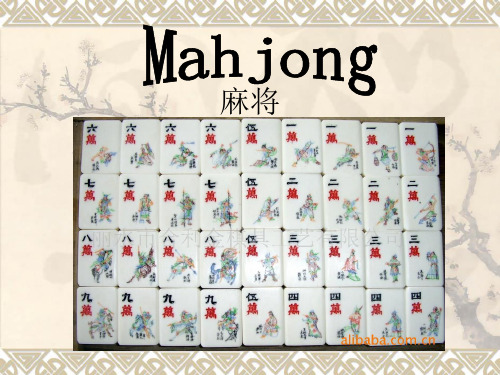
This was my best ever.a natural w Nhomakorabean 天胡
If you want to play mahjong, I will teach you. I'm sure you wil fell in love with it
Buzzwords of Mahjong
暗杠:drawing a tile by oneself 暗坎:concealing 3-tiles in order of a kind 八圈:eight rounds of play 边张:side tiles 吃张:drawing 抽头:the kitty 筹码:counter; chip; dib 出张:discarding a tile 大满贯:grand slam 单钓:waiting for one of the pair to win 单听:awaiting the only one necessary tile to win 地和:going out or winning a hand after drawing only one tile 吊牌:fishing; awaiting one’s winning tile 对对胡:winning with all paired tiles 对门:opponent sitting opposite to one 对碰:waiting for two tiles to win; making two pairs 杠后开花:drawing a tile 跟牌:following suit 进张:drawing a useful tile 扣牌:holding up a tile 拦和:be won by one’s left or opposing opponent with the same tile one needs 连庄:remaining the dealer 牌友:matching play 平和:a win without points 七对:seven pairs 砌牌:forming the wall of stacks 清一色:all of one suit; flush; having all tiles in one suit 全字:pure characters 缺一门:lacking a suit 三缺一:three players looking for one more player 上家:opponent on the left 十三幺:the thirteen orphans(1,9,and one of each character) 天和:a natural win; a heavenly hand 跳牌:skipping 听牌:waiting for the one necessary tile to win 洗牌:shuffling the tiles 下家:opponent on the right 一对:one pair 一番:one time (in scoring) 一圈:a round 一条龙:a complete sequence from 1 to 9 诈和:declaring a false win 庄家:dealer 自摸:winning by one’s own draw 做相公:be unconscious of a shortage or surplus of tiles
麻将中英文介绍
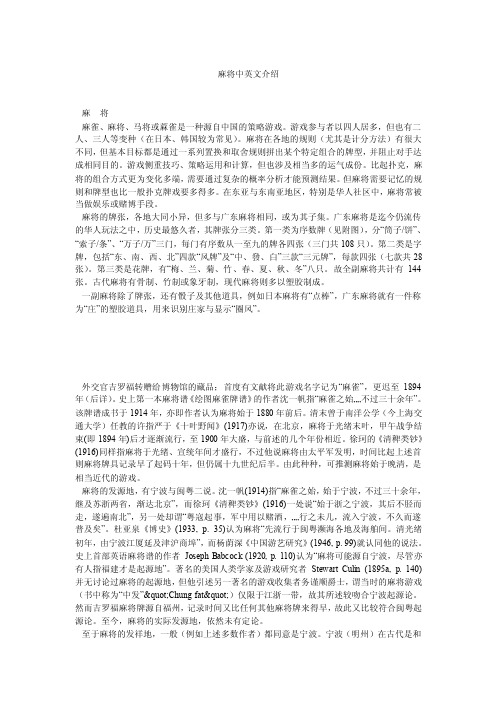
麻将中英文介绍麻将麻雀、麻将、马将或蔴雀是一种源自中国的策略游戏。
游戏参与者以四人居多,但也有二人、三人等变种(在日本、韩国较为常见)。
麻将在各地的规则(尤其是计分方法)有很大不同,但基本目标都是通过一系列置换和取舍规则拼出某个特定组合的牌型,并阻止对手达成相同目的。
游戏侧重技巧、策略运用和计算,但也涉及相当多的运气成份。
比起扑克,麻将的组合方式更为变化多端,需要通过复杂的概率分析才能预测结果。
但麻将需要记忆的规则和牌型也比一般扑克牌戏要多得多。
在东亚与东南亚地区,特别是华人社区中,麻将常被当做娱乐或赌博手段。
麻将的牌张,各地大同小异,但多与广东麻将相同,或为其子集。
广东麻将是迄今仍流传的华人玩法之中,历史最悠久者,其牌张分三类。
第一类为序数牌(见附图),分―筒子/饼‖、―索子/条‖、―万子/万‖三门,每门有序数从一至九的牌各四张(三门共108只)。
第二类是字牌,包括―东、南、西、北‖四款―风牌‖及―中、發、白‖三款―三元牌‖,每款四张(七款共28张)。
第三类是花牌,有―梅、兰、菊、竹、春、夏、秋、冬‖八只。
故全副麻将共计有144张。
古代麻将有骨制、竹制或象牙制,现代麻将则多以塑胶制成。
一副麻将除了牌张,还有骰子及其他道具,例如日本麻将有―点棒‖,广东麻将就有一件称为―庄‖的塑胶道具,用来识别庄家与显示―圈风‖。
外交官吉罗福转赠给博物馆的藏品;首度有文献将此游戏名字记为―麻雀‖,更迟至1894年(后详)。
史上第一本麻将谱《绘图麻雀牌谱》的作者沈一帆指―麻雀之始……不过三十余年‖。
该牌谱成书于1914年,亦即作者认为麻将始于1880年前后。
清末曾于南洋公学(今上海交通大学)任教的许指严于《十叶野闻》(1917)亦说,在北京,麻将于光绪末叶,甲午战争结束(即1894年)后才逐渐流行,至1900年大盛,与前述的几个年份相近。
徐珂的《清稗类钞》(1916)同样指麻将于光绪、宣统年间才盛行,不过他说麻将由太平军发明,时间比起上述首则麻将牌具记录早了起码十年,但仍属十九世纪后半。
麻将英文英文作文

麻将英文英文作文Mahjong, also known as mah-jongg, is a popular game that originated in China and has spread to various parts of the world. It is a game that requires skill, strategy, and a bit of luck, and it is often played by people of all ages. The game involves a set of tiles, each with different designs and symbols, and the objective is to create specific combinations or patterns with these tiles. Mahjong has become a significant part of Chinese culture and has gained popularity in other countries as well. In this essay, I will discuss the history of mahjong, its cultural significance, the rules of the game, and its impact on society.The history of mahjong dates back to the Qing Dynasty in China, where it is believed to have been created by a Chinese philosopher. The game was initially played by the ruling class and eventually spread to the general population. It gained popularity in the early 20th century and became a favorite pastime for many Chinese people. During the Chinese Civil War and the Cultural Revolution, mahjong was banned in China due to its association with gambling and decadence. However, the game continued to thrive in other parts of the world, especially in Hong Kong, Taiwan, and Japan. Today, mahjong is played in various countries, and it has become an integral part of Chinese culture.Mahjong holds significant cultural significance in China and other East Asian countries. It is often played during traditional festivals and family gatherings, bringing people together and fostering a sense of community. The game is also considered a symbol of luck and prosperity, and many people believe that playing mahjong can bring good fortune. In addition, mahjong has been depicted in various forms of art, literature, and media, further cementing its cultural importance. The game has also influenced the development of other games and has left a lasting impact on popular culture.The rules of mahjong are relatively simple, yet the game requires a great deal of skill and strategy to master. A standard set of mahjong tiles consists of 144 tiles, divided into different suits and categories. The objective of the game isto create specific combinations or patterns with these tiles, such as sets of three matching tiles or sequences of consecutive numbers. Players take turns drawing and discarding tiles, with the ultimate goal of completing a winning hand. Mahjong is a game that requires careful observation, calculation, and decision-making, making it an engaging and challenging pastime for many people.Mahjong has had a significant impact on society, influencing various aspects of culture, entertainment, and even technology. The game has inspired numerous adaptations, including digital versions, video games, and even online platforms. Mahjong has also become a popular subject in academic research and has been studied for its cognitive and social benefits. The game has also contributed to the development of problem-solving skills, memory retention, and social interaction, making it a valuable activity for people of all ages. Furthermore, mahjong has played a role in promoting cultural exchange and understanding, as it has been embraced by people from different backgrounds and has become a symbol of unity and diversity.In conclusion, mahjong is a game with a rich history, cultural significance, and a lasting impact on society. It has become an integral part of Chinese culture and has gained popularity in various parts of the world. The game's simple yet challenging rules make it an engaging pastime for people of all ages, and its influence extends to various aspects of culture, entertainment, and technology. Mahjong has brought people together, fostered a sense of community, and has become a symbol of luck and prosperity. Overall, mahjong is a game that continues to thrive and has left a lasting legacy on the world.。
麻将的历史发展和变迁

麻将的历史发展和变迁麻将的由来:麻将牌(又称麻雀牌)是由明末盛行的马吊牌、纸牌发展、演变而来的。
而马吊牌、纸牌等娱乐游戏,又都与我国历史上最古老的娱乐游戏——博戏有着千丝万缕的联系。
甚至是“血缘”关系。
现在流行的棋、牌等博弈戏娱,无不是在博戏的基础上发展、派生、演变而来的。
古博戏始于何时,准确年代很难说清。
据《史记》和其他有关文字的记载,博戏的产生至少在殷纣王之前。
我国最早的博戏叫“六博”,有六支箸和12个棋子,箸是一种长形的竹制品,相当于今天打麻将牌时所用的骰子。
据《颜氏家训·杂艺》所载,可知博戏又分大博、小博。
大博的行棋之法已不可考。
小博的玩法在《古博经》里有比较详细的记载。
其方法是:两人相对坐,棋盘为12道,两头当中为水。
把长方形的黑白各六个棋子放在棋盘上。
又用鱼两枚,置于水中。
比赛双方轮流掷琼(即骰子),根据掷采的大小,借以决定棋子前进的步数。
棋子到达终点,将棋子竖起来,成为骁棋(或称枭棋)。
成为骁的棋,便可入水“牵鱼”获筹。
获六筹为胜。
未成骁的棋,就称为散棋。
骁棋可以攻击对方的棋子,也可以放弃行走的机会而不动,散棋却不可。
麻将的转变:汉魏以后,博戏发生了根本性的变化。
博戏中的棋子脱离琼而独立行棋,向象棋方向发展,成为一种游戏。
而博戏的琼变为五木,即五个木制的骰子,也独立成为一种博戏用具,称为樗蒲。
以掷点分胜负。
相传这又为曹植所造的骰子当时用玉制成,后改用骨制。
变五木为两骰,立方体,其六面刻点,点数从一到六。
所以当时又叫“双六”。
博戏到了唐代,骰子成为一种独立的博具。
并且由两个骰子变为六个骰子。
据《西墅记》所载,唐明皇与杨贵妃掷骰子戏娱,唐明皇的战况不佳,只有让六个骰子中的两个骰子同时出现“四”才能转败为胜。
于是唐明皇一面举骰投掷,一面连呼“重四”。
骰子停定,正好重四。
唐明皇大悦,命令高力士将骰子的四点涂为红色,因此直到今天,骰子的幺、四两面为红色,其余四面都是黑色。
自唐代后,用六个骰子合成各种名目以决胜负的戏娱方法,在当时称为骰子格。
麻将英语演讲稿范文
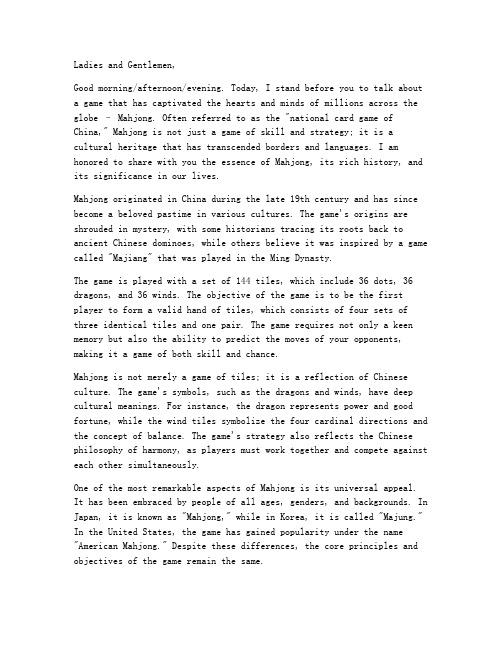
Ladies and Gentlemen,Good morning/afternoon/evening. Today, I stand before you to talk about a game that has captivated the hearts and minds of millions across the globe – Mahjong. Often referred to as the "national card game of China," Mahjong is not just a game of skill and strategy; it is a cultural heritage that has transcended borders and languages. I am honored to share with you the essence of Mahjong, its rich history, and its significance in our lives.Mahjong originated in China during the late 19th century and has since become a beloved pastime in various cultures. The game's origins are shrouded in mystery, with some historians tracing its roots back to ancient Chinese dominoes, while others believe it was inspired by a game called "Majiang" that was played in the Ming Dynasty.The game is played with a set of 144 tiles, which include 36 dots, 36 dragons, and 36 winds. The objective of the game is to be the first player to form a valid hand of tiles, which consists of four sets of three identical tiles and one pair. The game requires not only a keen memory but also the ability to predict the moves of your opponents, making it a game of both skill and chance.Mahjong is not merely a game of tiles; it is a reflection of Chinese culture. The game's symbols, such as the dragons and winds, have deep cultural meanings. For instance, the dragon represents power and good fortune, while the wind tiles symbolize the four cardinal directions and the concept of balance. The game's strategy also reflects the Chinese philosophy of harmony, as players must work together and compete against each other simultaneously.One of the most remarkable aspects of Mahjong is its universal appeal. It has been embraced by people of all ages, genders, and backgrounds. In Japan, it is known as "Mahjong," while in Korea, it is called "Majung." In the United States, the game has gained popularity under the name "American Mahjong." Despite these differences, the core principles and objectives of the game remain the same.Mahjong has also become a platform for cultural exchange. It brings people from diverse backgrounds together, fostering a sense of camaraderie and understanding. Whether you are playing with friends, family, or strangers, Mahjong provides an opportunity to connect and share stories. The game encourages players to be patient, polite, and respectful, as good sportsmanship is essential to the game.Moreover, Mahjong offers numerous benefits that extend beyond the gaming table. It improves cognitive skills, such as memory and concentration.It also promotes social interaction, as players must communicate and strategize to achieve victory. Furthermore, the game can serve as a therapeutic tool for those suffering from memory loss or cognitive decline.In conclusion, Mahjong is more than just a game; it is a cultural treasure that has stood the test of time. Its unique blend of strategy, skill, and cultural significance makes it a game that is cherished by people worldwide. As we gather to play Mahjong, let us remember its rich history and the bonds it fosters among us.Thank you for your attention, and may we all enjoy the art of Mahjong, one hand at a time.。
麻将的作文英语

Mahjong holds a special place in Chinese culture and is often played during festivals, family gatherings, and social events. The game is not only a form of entertainment but also a way for people to socialize and bond with one another. In addition, Mahjong is often depicted in Chinese art and literature, further emphasizing its cultural significance.
VI. Mahjong in the Modern World
In recent years, Mahjong has gained popularity outside of China, with many people around the world embracing the game and forming Mahjong clubs and associations. The game has also been adapted into digital formats, making it more accessible to a wider audience. Despite its modernization, Mahjong continues to preserve its traditional charm and remains a beloved pastime for people of all ages.
中国古代休闲活动英语作文

中国古代休闲活动英语作文Mahjong is not only a game invented in ancient China,but also one of the most popular leisure activities in China.麻将是一种中国古发明的博弈游戏,也是一种现今中国人最受欢迎的一种休闲活动。
It is a small square made of bamboo, bone or plastic, with patterns or words engraved on it.牌类娱乐用具,用竹子、骨头或塑料制成的小长方块,上面刻有花纹或字样。
It can be said that mahjong is actually a combination of cards and bone cards.可以说麻将牌实际上是一种纸牌与骨牌的结合体。
Compared with other forms of dominoes, the playing method of mahjong is the most complex and interesting. Its basic playing method is simple and easy to use.与其他骨牌形式相比,麻将的玩法最为复杂有趣,它的基本打法简单,容易上手。
However,there are many changes and the collocations vary from person to person, so it has become one of the most attractiveforms in Chinese history.但其中变化又极多,搭配组合因人而异,因此成为中国历史上一种最能吸引人的博戏形式之一。
At the same time of the popularity of horse tag in Ming Dynasty,a kind of entertainment equipment named "playing cards" was derived from horse tag. There are 60 cards at the beginning.在明代马吊牌盛行的同时,由马吊牌又派生出一种叫“纸牌”的戏娱用具。
麻将说明文作文
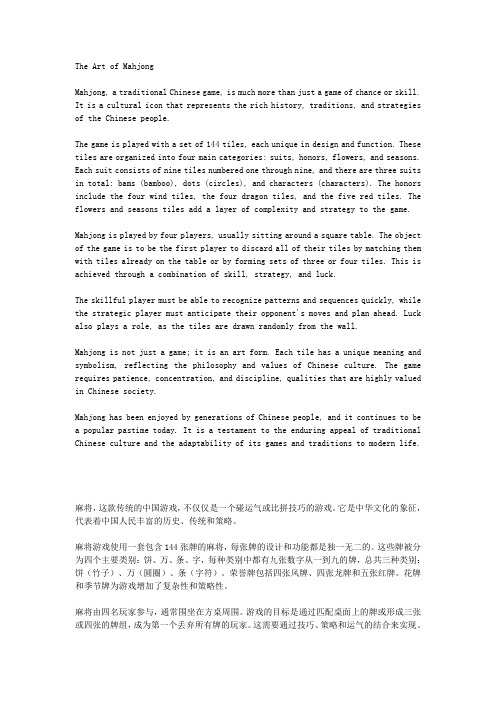
The Art of MahjongMahjong, a traditional Chinese game, is much more than just a game of chance or skill. It is a cultural icon that represents the rich history, traditions, and strategies of the Chinese people.The game is played with a set of 144 tiles, each unique in design and function. These tiles are organized into four main categories: suits, honors, flowers, and seasons. Each suit consists of nine tiles numbered one through nine, and there are three suits in total: bams (bamboo), dots (circles), and characters (characters). The honors include the four wind tiles, the four dragon tiles, and the five red tiles. The flowers and seasons tiles add a layer of complexity and strategy to the game.Mahjong is played by four players, usually sitting around a square table. The object of the game is to be the first player to discard all of their tiles by matching them with tiles already on the table or by forming sets of three or four tiles. This is achieved through a combination of skill, strategy, and luck.The skillful player must be able to recognize patterns and sequences quickly, while the strategic player must anticipate their opponent's moves and plan ahead. Luck also plays a role, as the tiles are drawn randomly from the wall.Mahjong is not just a game; it is an art form. Each tile has a unique meaning and symbolism, reflecting the philosophy and values of Chinese culture. The game requires patience, concentration, and discipline, qualities that are highly valued in Chinese society.Mahjong has been enjoyed by generations of Chinese people, and it continues to be a popular pastime today. It is a testament to the enduring appeal of traditional Chinese culture and the adaptability of its games and traditions to modern life.麻将,这款传统的中国游戏,不仅仅是一个碰运气或比拼技巧的游戏。
麻将英语作文100字
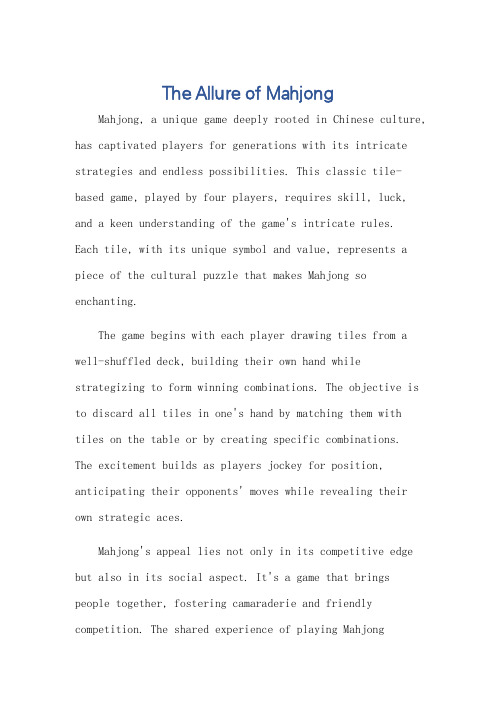
The Allure of MahjongMahjong, a unique game deeply rooted in Chinese culture, has captivated players for generations with its intricate strategies and endless possibilities. This classic tile-based game, played by four players, requires skill, luck, and a keen understanding of the game's intricate rules.Each tile, with its unique symbol and value, represents a piece of the cultural puzzle that makes Mahjong so enchanting.The game begins with each player drawing tiles from a well-shuffled deck, building their own hand while strategizing to form winning combinations. The objective is to discard all tiles in one's hand by matching them withtiles on the table or by creating specific combinations.The excitement builds as players jockey for position, anticipating their opponents' moves while revealing their own strategic aces.Mahjong's appeal lies not only in its competitive edge but also in its social aspect. It's a game that brings people together, fostering camaraderie and friendly competition. The shared experience of playing Mahjongcreates a bond among players, as they share laughter, strategy, and the occasional triumph or defeat.In addition to its娱乐价值, Mahjong also reflects the rich history and culture of China. The tiles, often adorned with traditional symbols like flowers, dragons, and bats, are testaments to the game's deep cultural roots. Byplaying Mahjong, players are not only engaging in a gamebut also participating in a cultural tradition that spans centuries.Overall, Mahjong is much more than just a game; it's a cultural phenomenon that combines strategy, luck, andsocial interaction. Its popularity across China and beyondis a testament to its enduring charm and the enduring power of traditional culture.**麻将的魅力**麻将,这款深深植根于中国文化的独特游戏,凭借其错综复杂的策略和无穷的可能性,让数代玩家为之着迷。
麻将英文演讲稿
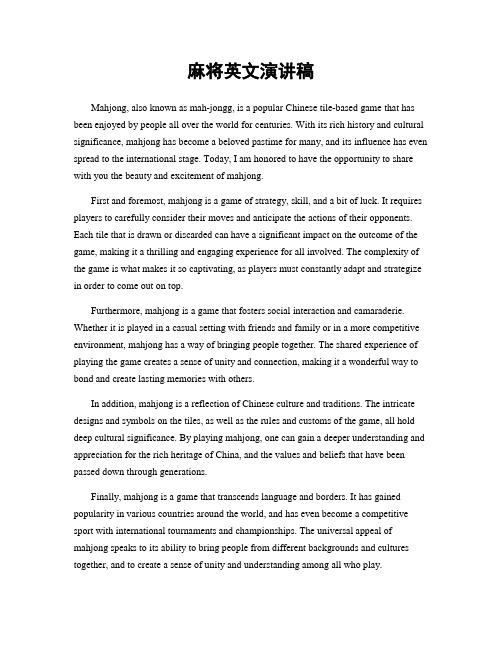
麻将英文演讲稿Mahjong, also known as mah-jongg, is a popular Chinese tile-based game that has been enjoyed by people all over the world for centuries. With its rich history and cultural significance, mahjong has become a beloved pastime for many, and its influence has even spread to the international stage. Today, I am honored to have the opportunity to share with you the beauty and excitement of mahjong.First and foremost, mahjong is a game of strategy, skill, and a bit of luck. It requires players to carefully consider their moves and anticipate the actions of their opponents. Each tile that is drawn or discarded can have a significant impact on the outcome of the game, making it a thrilling and engaging experience for all involved. The complexity of the game is what makes it so captivating, as players must constantly adapt and strategize in order to come out on top.Furthermore, mahjong is a game that fosters social interaction and camaraderie. Whether it is played in a casual setting with friends and family or in a more competitive environment, mahjong has a way of bringing people together. The shared experience of playing the game creates a sense of unity and connection, making it a wonderful way to bond and create lasting memories with others.In addition, mahjong is a reflection of Chinese culture and traditions. The intricate designs and symbols on the tiles, as well as the rules and customs of the game, all hold deep cultural significance. By playing mahjong, one can gain a deeper understanding and appreciation for the rich heritage of China, and the values and beliefs that have been passed down through generations.Finally, mahjong is a game that transcends language and borders. It has gained popularity in various countries around the world, and has even become a competitive sport with international tournaments and championships. The universal appeal of mahjong speaks to its ability to bring people from different backgrounds and cultures together, and to create a sense of unity and understanding among all who play.In conclusion, mahjong is a timeless game that has stood the test of time and continues to captivate people of all ages and backgrounds. Its strategic depth, social nature, cultural significance, and global appeal make it a truly remarkable pastime. Whether you are a seasoned player or someone who is new to the game, I encourage you to experience the joy and excitement of mahjong for yourself. Thank you.。
打麻将家庭娱乐英语作文

打麻将家庭娱乐英语作文In the heart of many Chinese homes, the sound of mahjong tiles clicking together is often a familiar and welcoming melody. This traditional game, known for its strategic complexity and social charm, has become a cherished part of family entertainment, bringing together generations and fostering a sense of camaraderie.The allure of mahjong lies in its ability to strike a harmonious balance between competition and camaraderie. While each player strives to outwit the others and secure a winning hand, the game also requires a level of cooperation and mutual respect. This dynamic creates a unique atmosphere where winning is celebrated, but defeat is also met with good humor and understanding.In a family setting, mahjong sessions often double as opportunities for storytelling and sharing. Over the course of a game, parents might recount tales of their own childhoods, while children listen intently, eager to learn more about their heritage. Conversations flow freely, covering a range of topics from daily life to deeper philosophical discussions. These spontaneous exchanges notonly strengthen family bonds but also provide valuable insights into each other's lives.Moreover, mahjong serves as a great tool for cognitive training. The game requires players to quickly assess patterns, calculate probabilities, and make strategic decisions under pressure. These mental exercises can help improve cognitive functions such as memory, attention, and problem-solving skills.From a cultural perspective, mahjong represents a significant part of Chinese heritage. The game's rich history and symbolism add another layer of depth to family gatherings. As players shuffle and deal the tiles, they are not just engaging in a game; they are also participating in a centuries-old tradition that connects them to their ancestors and the rich cultural legacy of their people.In conclusion, playing mahjong as a family entertainment activity is much more than just a game. It's a way of life that fosters togetherness, stimulates cognitive function, and preserves cultural values. As families continue to embrace this timeless tradition, the joy of playing mahjong among them will undoubtedly persist,serving as a constant reminder of the warmth and joy that can be found in simple moments shared with loved ones.**麻将:家庭娱乐的欢乐源泉**在许多中国家庭的中心,麻将牌相互碰撞的声音常常是一首熟悉而亲切的旋律。
麻将的英语作文
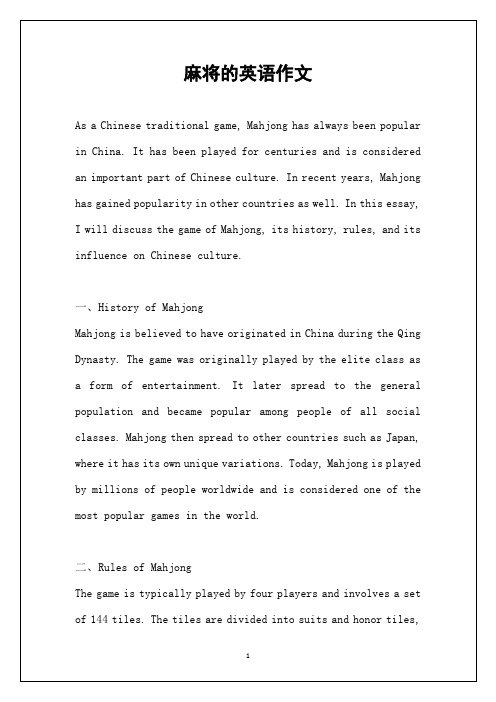
六、Personal Experience with Mahjong
Growing up in a Chinese household,I have fond memories of playing Mahjong with my family and friends. It was a way for us to come together, socialize, and have fun. Playing Mahjong also helped me improve my critical thinking and decision-making skills. Even now, as an adult, I still enjoy playing Mahjong with my loved ones. It has become a cherished tradition that brings us closer together and allows us to celebrate our cultural heritage.
麻将的由来英语作文
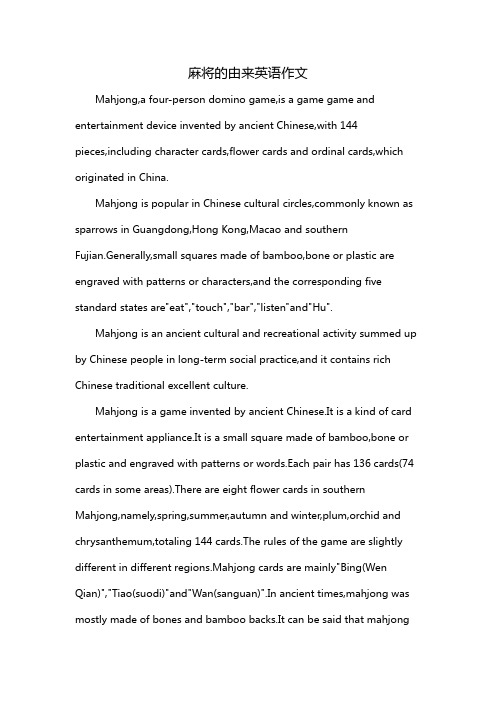
麻将的由来英语作文Mahjong,a four-person domino game,is a game game and entertainment device invented by ancient Chinese,with 144pieces,including character cards,flower cards and ordinal cards,which originated in China.Mahjong is popular in Chinese cultural circles,commonly known as sparrows in Guangdong,Hong Kong,Macao and southernFujian.Generally,small squares made of bamboo,bone or plastic are engraved with patterns or characters,and the corresponding five standard states are"eat","touch","bar","listen"and"Hu".Mahjong is an ancient cultural and recreational activity summed up by Chinese people in long-term social practice,and it contains rich Chinese traditional excellent culture.Mahjong is a game invented by ancient Chinese.It is a kind of card entertainment appliance.It is a small square made of bamboo,bone or plastic and engraved with patterns or words.Each pair has 136 cards(74 cards in some areas).There are eight flower cards in southern Mahjong,namely,spring,summer,autumn and winter,plum,orchid and chrysanthemum,totaling 144 cards.The rules of the game are slightly different in different regions.Mahjong cards are mainly"Bing(Wen Qian)","Tiao(suodi)"and"Wan(sanguan)".In ancient times,mahjong was mostly made of bones and bamboo backs.It can be said that mahjongtiles are actually a combination of cards and pared with other forms of dominoes,mahjong is the most complicated and interesting game.Its basic game is simple and easy to use,but there are many changes in it.The collocation and combination vary from person to person,so it has become one of the most attractive forms of gambling in Chinese history.。
介绍麻将英语作文300字
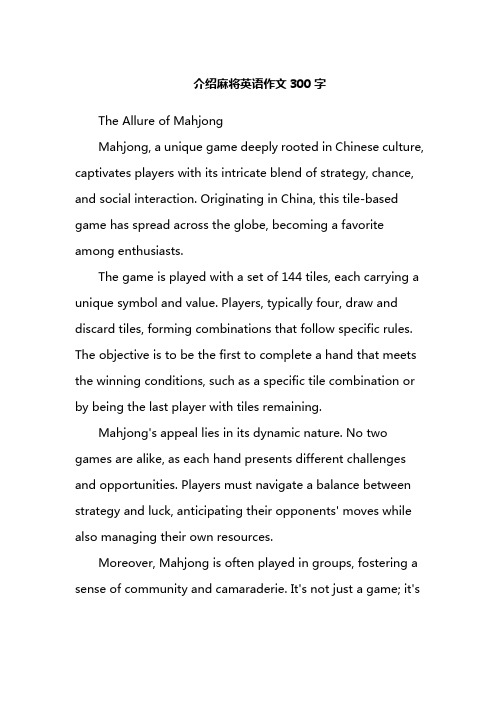
介绍麻将英语作文300字The Allure of MahjongMahjong, a unique game deeply rooted in Chinese culture, captivates players with its intricate blend of strategy, chance, and social interaction. Originating in China, this tile-based game has spread across the globe, becoming a favorite among enthusiasts.The game is played with a set of 144 tiles, each carrying a unique symbol and value. Players, typically four, draw and discard tiles, forming combinations that follow specific rules. The objective is to be the first to complete a hand that meets the winning conditions, such as a specific tile combination or by being the last player with tiles remaining.Mahjong's appeal lies in its dynamic nature. No two games are alike, as each hand presents different challenges and opportunities. Players must navigate a balance between strategy and luck, anticipating their opponents' moves while also managing their own resources.Moreover, Mahjong is often played in groups, fostering a sense of community and camaraderie. It's not just a game; it'san experience that brings people together, sharing joy, frustration, and laughter over the tiles.In conclusion, Mahjong is much more than a game; it's a cultural phenomenon that embodies the essence of Chinese traditions and values. Its rich history, combined with its dynamic gameplay and social aspect, make it a timeless classic that continues to captivate players worldwide.。
- 1、下载文档前请自行甄别文档内容的完整性,平台不提供额外的编辑、内容补充、找答案等附加服务。
- 2、"仅部分预览"的文档,不可在线预览部分如存在完整性等问题,可反馈申请退款(可完整预览的文档不适用该条件!)。
- 3、如文档侵犯您的权益,请联系客服反馈,我们会尽快为您处理(人工客服工作时间:9:00-18:30)。
Majiang HistoryThere are two theories about the origin of Majiang. The first theory suggests that Confucius, the great Chinese philosopher, developed the game about 500 BC. The second theory implies that the game was developed from existing Chinese card and domino games sometime around 1850.The following information supports the first theory:∙Majiang emerged in various Chinese provinces at the time when Confucius was teaching his new doctrines.∙The three dragon (Cardinal) tiles coincide with the three Cardinal virtues taught by Confucius. These are:o Zhongo Fao Bai∙Confucius was said to be fond of birds, which would explain the name "Majiang", meaning hemp bird or hemp sparrow.∙Terminologies used in Majiang like Pong, Chee and Kong. Confucius was of the Kong family his full name being Kong-Qiu, he married a girl named Che and adopted the termChee meaning 'to connect' which Westerners corrupted into Chow.On the other hand, the following information supports the second theory:∙Some historians believe that Majiang was based on a card game called Mádìao (also known as Ma Tiae, meaning Hanging Horse; or Yèzí, meaning Leaf) in the early Mingdynasty.This game was played with 40 paper cards similar in appearance to the cards used in thegame Ya Pei. These forty cards, numbered 1 to 9 in four different suits along with fourextra flower cards, are quite alike to the numbering of Majiang tiles today.There is still a healthy debate about to whom the creation of the game should beattributed. One theory is that Chinese army officers serving during the Tai Ping Rebellioncreated the game to pass the time. Another theory is that a noble living in the Shanghaiarea created the game between 1870 and 1875. It is thought that around 1850 in the cityof Ningpo two brothers had created Majiang from the earlier game of Mádìao.In 1895, an American anthropologist named Stewart Culin wrote a paper in which Majiang was mentioned. This is the first known written account of Majiang in any language other than Chinese.By 1910, there were written accounts about Majiang in many languages including French and Japanese. An important English read was Joseph Park Babcock's Rules of Mah-Jongg, which, simplified in 1920, was simply known as the "red book". Although this was the earliest version of Majiang that had been introduced to America, many of Babcock's simplifications are abandoned nowadays.Majiang was a sensation in America when it was imported from China in the 1920s, with the same Majiang game taking on a number of trademarked names, such as Pong Chow or the Game of Thousand Intelligences. Part of Majiang nights in America were to decorate rooms in Chinese style and dress like Chinese. Several hit songs were also recorded during the Majiang fad, most notably Since Ma is Playing Majiang by Eddie Cantor.American Majiang, which was mainly played by women during the time, grew from this craze, and in the 1930s, after many revisions of the rules (including some that were considered fundamentals in other variants, such as the notion of a standard hand) led to the formation of the National Majiangg League (NMJL) in 1937, along with the first American Majiang rulebook, Maajh: The American Version of the Ancient Chinese Game.Despite it being Chinese in origin and accepted by players of all racial backgrounds when first introduced by Babcock, American Majiang is considered a Jewish game, as many American Majiang players are of Jewish descent, and the NMJL was founded by Jewish players and considered a Jewish organization.But, at the same time, this traditional Chinese game was banned in its homeland in 1949, when the People's Republic of China was founded. The new Communist government forbade any gambling activities, which were regarded as symbols of capitalist corruption. After the Cultural Revolution, the game was revived, and once again Majiang has become one of the most favorite pastimes of the Chinese people.Today, the popularity and demographic of players of Majiang varies from country to country. In America, most players of American Majiang are women. In Japan, there has been a much greater emphasis on gambling before other legal public gambling were devised and the gender of the players is much less divided. There are also many governing bodies of Majiang, many of them hosting exhibition games and tournaments. In Japan, video arcades have introduced Majiang arcade machines that can be connected to others over the internet, as well as video games that allow a victorious player to view pictures of women in varying stages of undress.Majiang culture is still deeply ingrained in the Chinese community: Sam Hui wrote Cantopop songs, using Majiang as their themes. Chinese movies have always included scenes of Majiang games. Gambling movies have been filmed time and again in Hong Kong, and a recent sub-genre is the Majiang movie.。
